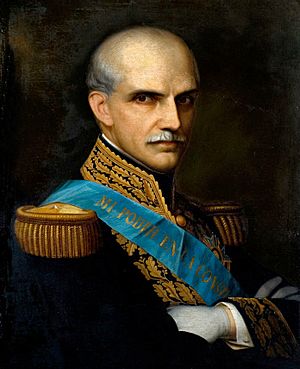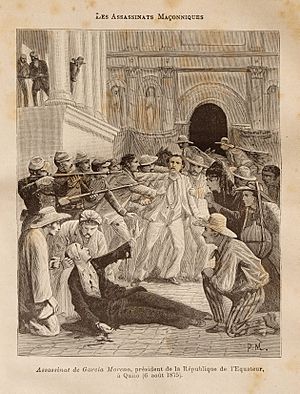Gabriel García Moreno facts for kids
Quick facts for kids
Gabriel García Moreno
|
|
|---|---|
 |
|
| 7th President of Ecuador | |
| In office 10 August 1869 – 6 August 1875 |
|
| Vice President | Francisco Javier León (1869–1875) |
| Preceded by | Manuel de Ascásubi |
| Succeeded by | Francisco Javier León |
| In office 2 April 1861 – 30 August 1865 |
|
| Vice President | Mariano Cueva Antonio Borrero Rafael Carvajal |
| Preceded by | Himself (as Interim President) |
| Succeeded by | Rafael Carvajal |
| Interim President of Ecuador | |
| In office 19 January 1869 – 19 May 1869 |
|
| Preceded by | Juan Javier Espinosa |
| Succeeded by | Manuel de Ascásubi |
| In office 17 January 1861 – 2 April 1861 |
|
| Preceded by | Francisco Robles |
| Succeeded by | Himself (as President) |
| Personal details | |
| Born | 24 December 1821 Guayaquil, Ecuador |
| Died | 6 August 1875 (aged 53) Quito, Ecuador |
| Political party | Conservative Party |
| Spouses | Rosa de Ascásubi Mariana del Alcázar |
| Signature | |
Gabriel García Moreno (born December 24, 1821 – died August 6, 1875) was an important Ecuadorian politician. He served as President of Ecuador two times. His first term was from 1861 to 1865. His second term was from 1869 until his death in 1875. He was killed during his second term.
García Moreno was known for his strong conservatism. He believed deeply in the Catholic Church and its role in society. He also had a rivalry with liberal leader Eloy Alfaro. García Moreno worked hard to improve Ecuador's economy and farming. He was also very against corruption.
Contents
Gabriel García Moreno's Life
Gabriel García Moreno was born in 1821 in Guayaquil, Ecuador. His father was a Spanish nobleman. His mother came from a rich family in Ecuador. His father died when Gabriel was young. His mother, who was very Catholic, raised him. This made him a very religious person.
He studied theology (the study of religion) and law at the University of Quito. For a short time, he thought about becoming a priest. But his friends and his own interests led him to a career in law and politics. He became a lawyer in 1844.
He started as a lawyer and journalist. He wrote against the liberal government at the time. In 1849, he traveled to Europe for two years. He wanted to see the effects of the revolutions of 1848.
Becoming President
When he came back to Ecuador, he found the country had strong anti-religious feelings. He was elected as a senator. He became very well-known. After a civil war, he became president in 1860. In 1861, people voted for him to be president for a four-year term.
After his first term, his successor was removed from power by liberals in 1867. García Moreno was elected president again in 1869. He was re-elected for a third time in 1875. During his time as president, he helped Ecuador grow. He also made the country more closely tied to Catholicism.
His Strong Catholic Beliefs
García Moreno was a very religious man. He went to Mass every day. He also visited the Blessed Sacrament and received Holy Communion every Sunday. This was not common at the time.
He made it a main goal of his government to support Catholicism. The 1869 constitution made Catholicism the official religion of Ecuador. It also required that both voters and candidates be Catholic. He was the only leader in the world to protest when the Pope lost the Papal States. Two years later, he had the government dedicate Ecuador to the Sacred Heart of Jesus. Some people believe this act made him a target for his enemies.
García Moreno also became friends with the Society of Jesus (Jesuits). He helped some Jesuits from Germany find safety in Ecuador. He also wanted laws that would ban secret societies.
Improving Ecuador's Economy
When García Moreno became president, Ecuador's government had no money and a huge debt. To fix this, he made the government spend less. He also got rid of many jobs and stopped corruption. This helped the country's finances. It also brought in money from other countries.
He started many public works projects. These projects were partly paid for by a tax called trabajo subsidario. This tax required every citizen to work four days a year for the government without pay. Or they could pay money instead. This tax was similar to an old colonial labor system. It affected Ecuador's native people the most. They often could not pay to avoid the work.
In 1862, García Moreno took control of these tax funds. He wanted to use them for big projects across the country. This made some local areas unhappy. They wanted the money for their own projects. With these funds, García Moreno started building a famous highway system. He used workers from the trabajo subsidario requirement to build these roads.
While the roads were good for the country, García Moreno has been criticized. People say he used forced labor to build these highways. They also say native workers were treated badly during construction. One writer, Friedrich Hassaurek, saw the road being built. He described native people working without enough tools. He said they worked unwillingly and were forced by whips.
Besides roads, García Moreno also improved education. He reformed universities. He started two polytechnic (technical) and agricultural colleges. He also opened a military school. The number of primary schools grew from 200 to 500. The number of students in primary schools went from 8,000 to 32,000.
Political Challenges and Death
Many liberals did not like García Moreno. They saw his rule as too strict and conservative. They also disliked his use of secret police to stop people who disagreed with him. Some people called him a dictator. Liberals were also angry that his policies continued even after his first term.
This opposition led Juan Montalvo to write a pamphlet called La dictadura perpetua (The Perpetual Dictatorship). This writing inspired people to plan to kill García Moreno.
García Moreno was killed on August 6, 1875. He was attacked on the steps of the National Palace in Quito. Faustino Rayo attacked him with a machete. Other attackers shot him with revolvers. His last words were: "¡Dios no muere!" ("God does not die!").
The day before his death, a priest warned García Moreno. The priest said that Freemasons had planned his death. García Moreno replied that he had already been warned. He said he was ready to meet God.
Legacy
Pope Leo XIII wrote that García Moreno "fell under the steel of the wicked for the Church."
In 1939, the process to make García Moreno a saint began. This process is called beatification. However, this process slowed down after the Second Vatican Council in the 1970s.
Images for kids
See also
 In Spanish: Gabriel García Moreno para niños
In Spanish: Gabriel García Moreno para niños


